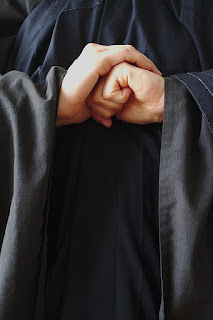The Middle Way: Balancing Stillness and Motion
By Gary Enns
5 March 2022 | Saturday Morning Kusen

With stillness and motion we find the Middle Way.
In zazen, for instance, we stretch the backbone, the head presses the sky, the exhale deepens and lengthens. In shikantaza (just sitting) there is a point of balance that allows us to sit for extended periods of time. Yet if striving enters the mix, we may tend toward over-tuning: we may reach for an even longer, deeper exhale, yet with this, the abdominal muscles begin to flex and tense up; we may sit taller still, yet too far, and our vertebrae hyperextend and we tire. Can we sit too long? If our quietude begins to crowd out other essential elements of our life practice, then yes. Striving often leads us too far, from balance to imbalance. What is too much? Too little? Just right? If in our practice we continue to truly listen and respond to the needs of the world (which include our own needs), our Foucault’s pendulum settles closer and closer to the center, and we come closer and closer to our answer.
Our practice, of course, extends beyond zazen. Consider for a moment why we do kinhin (walking meditation) in the dojo? And why samu (work practice)? If zazen is our main practice, why not simply sit?
True, our lives may benefit from more zazen, but only when our choice of more is a measured one that listens to the needs of our entire being and the needs of the sangha (community of practitioners). A complete practice means both stilling the body and moving the body, both serving the individual and serving the greater good. For this reason we balance—or tune—between stillness and motion. We sit like mountains in zazen and then walk like mountains in kinhin; we do gassho (hands together); we do pai (prostration); in transition, we bend to the right and left to reacquaint our bodies with the feeling of movement; during kinhin we stretch the knees. With stillness and motion we find the Middle Way.
Our balance extends beyond our immediate selves to the sangha and the temple. Listening to and honoring the needs of the greater body, we get up from the zafu to practice our Zen in the form of samu—cleaning, building, repairing, cooking in mushotoku spirit (no personal gain) for the benefit of others. In this way the stillness of our personal practice is balanced with the activity and work we do for the world beyond ourselves.
We are attuned to the Middle Way when we balance stillness with movement, quietude with sound, individual with whole. Whether sitting, walking, or chanting, cleaning, cooking, or building, each moment of stillness or activity is its own dharma gate in the here and now, ready and waiting for us to pass through.
Works Cited
Bassis, Kinrei. “The Middle Way.” Berkeley Buddhist Priory, berkeleybuddhistpriory.org, 27 Feb. 2020. Accessed 5 March 2022.
"Posture des mains en kinhin." Zen Deshimaru, CC BY-SA 4.0, Wikimedia Commons. Accessed 5 March 2022.

Comments
Post a Comment